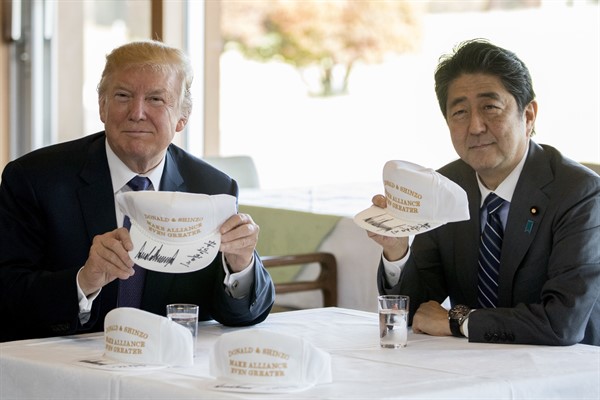The assassination of Abe Shinzo last week left the world in shock. As Japan’s longest-serving prime minister—having held office from 2006 to 2007 and again from 2012 until 2020—Abe left an indelible and controversial impact on Japanese politics and policy. This was particularly the case in foreign policy. Though he was never able to successfully revise Japan’s pacifist postwar constitution, he did move Japan along the path toward becoming a “normal country,” that is, one able to pursue its interests through all available means, including military force.
But one of Abe’s greatest accomplishments, at least in the realm of international politics, might have been to navigate the tricky waters of former U.S. President Donald Trump’s time in office. As one of the United States’ core, long-standing formal alliances, the U.S.-Japan partnership is a central component of the global security architecture that backstops what is commonly referred to as the U.S.-led liberal international order. Given Trump’s disdain for international institutions and his penchant for abrasive rhetoric—especially when it came to chastising Washington’s traditional partners—all U.S. allies were put on notice when he took office. This skepticism of alliances and multilateralism was particularly concerning in Tokyo, due to Trump’s long-standing animosity toward Japan. As far back as 1987, in a full-page ad he took out in The New York Times, Washington Post and Boston Globe, Trump wrote, “For decades, Japan and other nations have been taking advantage of the United States.” So, in addition to fears that Trump would upend the pillars of the established global order, there were worries in Tokyo that he might start with the U.S.-Japan alliance.
But while Trump did create chaos within the Group of 7, of which the United States and Japan are key members, and withdraw the United States from some international organizations, the U.S. remained within the core institutions of the international system. And while he added turbulence to Washington’s relations with its allies, both NATO and the U.S.-Japan alliance survived intact. This was no small feat. But the U.S.-Japan alliance didn’t just survive the Trump years. It thrived. And that was thanks to Abe, who skillfully navigated the challenge Trump represented in several ways.

